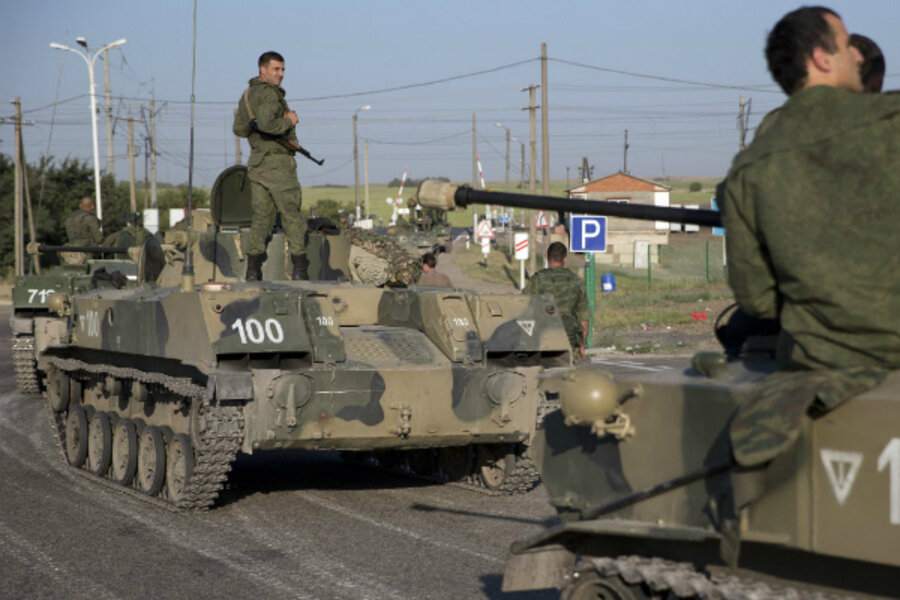Ukraine tensions rise again, NATO accuses Russia of 'escalating' conflict
Loading...
| Washington
Hostilities in eastern Ukraine appeared to slip closer to the full-blown confrontation between Russia and the West that both sides say they want to avoid, as NATO accused Russia of “escalating” the conflict and Ukraine claimed to have destroyed Russian armored vehicles that crossed into its territory.
The heightened tensions arise with no meaningful diplomatic contacts under way either between the warring Ukrainian sides or between Russia and the West, and they provided an example of the kind of provocation or misstep that regional experts have warned for months could lead to a broader conflict.
Ukrainian officials said on Friday that their forces had “destroyed” part of a “significant” column of Russian military vehicles that had crossed under cover of darkness into eastern Ukraine, where Ukrainian security forces are battling pro-Russia separatists.
The Russian Defense Ministry denied Ukraine’s claims, but NATO decried the incursion as “further evidence that Russia is doing the very opposite of what it’s saying.”
NATO Secretary General Anders Fogh Rasmussen said, in remarks in Denmark, that a “Russian incursion” had occurred during the night, and he called it “a clear demonstration of continued Russian involvement in the destabilization of eastern Ukraine.”
Russia countered the Ukrainian claims by saying it had intelligence suggesting that Ukrainian security forces were intending to attack a convoy of hundreds of Russian trucks claiming to bring tons of humanitarian aid to besieged eastern Ukraine.
Ukrainian officials have been on edge in recent days over the approaching convoy of more than 260 trucks, fearing they might contain military supplies meant as replenishment for separatist forces that appear to be gradually losing ground to government forces.
A plan for inspecting the trucks was still under discussion Friday, although some partial access to the trucks revealed only items such as food and medical supplies. But many of the trucks were less than half full, raising concerns on the Ukrainian side that the trucks intended to pick up military equipment before crossing into eastern Ukraine.
International tensions over Ukraine have spiked before, most recently after a Malaysian airliner was shot down in July over eastern Ukraine, killing 298 people aboard. But the risks of broader confrontation are greater now, some regional experts say – not just because of a claim of a Russian incursion into Ukraine, but because, over recent weeks and months, both sides have raised the stakes in the conflict.
“We may now have evidence of the first direct clash between Ukrainian and Russian forces,” says Nikolas Gvosdev, a Russia expert at the Naval War College in Newport, R.I. “We’ve reached a point,” he adds, “where we may look back” over the trajectory of actions, counteractions, and escalation of interests, “and conclude that this was a very predictable crisis.”
At the end of last year, Dr. Gvosdev says, it appeared that Ukraine mattered to the United States and the West “only to a certain point” and not to a level warranting a retreat from relations with Russia. “But now, Ukraine has been elevated to the status of a vital American interest,” he adds. American leaders “need to be able to articulate why [Ukraine reaches] that level of national interest.”
President Obama may have an opportunity to “articulate” that national interest early next month when he visits the Baltic states on his way to a NATO summit in Wales. In Tallinn, the capital of Estonia, Mr. Obama will meet with the leaders of Estonia, Latvia, and Lithuania – NATO members that have expressed concerns about Russian intentions in the “former Soviet space” as a result of Russia’s actions in Ukraine.
In its announcement Friday of Obama’s Estonia visit, the White House said the president would use the trip to “reaffirm our ironclad commitment” to the NATO treaty, which stipulates that “an armed attack against one ... shall be considered an attack against ... all [members].”
Ukraine is not officially on a track to membership in NATO, but NATO officials continue to say the door to membership is “open” – even though Russia says that Ukraine in NATO constitutes a red line.
Gvosdev says Obama will aim to express as strong support of the Baltic states as he can without getting “locked in” to ordering US action in the face of any kind of Russian interference in the Baltics, which he says could range from economic and political pressures to some form of “military incursion.”
“He’s going to give as much reassurance as he can with as little specificity as he can,” he says.
As for Ukraine, Gvosdev says, the stop in Tallinn will hardly be the moment for Obama to come forward with some kind of grand bargain to defuse the Ukrainian crisis embroiling the West and Russia.
“I can’t see that he’s going to go there,” he says. “He’s not going to come out with some big compromise in Estonia.”








